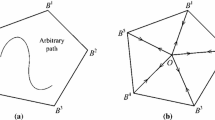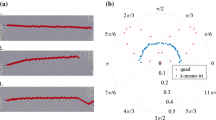Abstract
Direct methods aim to find the maximum load factor that a domain made of a plastic material can sustain before undergoing full collapse. Its analytical solution may be posed as a constrained maximisation problem, which is computationally solved by resorting to appropriate discretisation of the relevant fields such as the stress or velocity fields. The actual discrete solution is though strongly dependent on such discretisation, which is defined by a set of nodes, elements, and the type of interpolation. We here resort to an adaptive strategy that aims to perturb the positions of the nodes in order to improve the solution of the discrete maximisation problem. When the positions of the nodes are taken into account, the optimisation problem becomes highly non-linear. We approximate this problem as two staggered linear problems, one written in terms of the stress variable (lower bound problem) or velocity variables (upper bound problem), and another with respect to the nodal positions. In this manner, we show that for some simple problems, the computed load factor may be further improved while kee** a constant number of elements.
Access this chapter
Tax calculation will be finalised at checkout
Purchases are for personal use only
Similar content being viewed by others
References
Boyd S, Vandenberghe L (2004) Convex optimization. Cambridge University, Press
Cottereau R, Díez P (2015) Fast r-adaptivity for multiple queries of heterogeneous stochastic material fields. Comput Mech 66:601–612
Hambleton J, Sloan S (2013) A perturbation method for optimization of rigid block mechanisms in the kinematic method of limit analysis. Comput Geotech 48:260–271
Kim J, Panatinarak T, Shontz SM (2013) A multiobjective mesh optimization framework for mesh quality improvement and mesh untangling. Int J Numer Methods Eng 94(7):20–42
Krabbenhøft K, Lyamin AV, Hjiaj M, Sloan SW (2005) A new discontinuous upper bound limit analysis formulation. Int J Numer Methods Eng 63:1069–1088
Lyamin AV, Sloan SW (2002a) Lower bound limit analysis using non-linear programming. Int J Numer Methods Eng 55:576–611
Lyamin AV, Sloan SW (2002b) Upper bound limit analysis using linear finite elements and non-linear programming. Int J Numer Anal Methods Geomech 26:181–216
Lyamin AV, Sloan SW, Krabbenhøft K, Hjiaj M (2005) Lower bound limit analysis with adaptive remeshing. Int J Numer Methods Eng 63:1961–1974
Ma L, Klug WS (2008) Viscous regularization and r-adaptive remeshing for finite element analysis of lipid membrane mechanics. J Comput Phys 227(11):5816–5835
Muñoz JJ, Bonet J, Huerta A, Peraire J (2009) Upper and lower bounds in limit analysis: adaptive meshing strategies and discontinuous loading. Int J Numer Methods Eng 77:471–501
Muñoz JJ, Bonet J, Huerta A, Peraire J (2012) A note on upper bound formulations in limit analysis. Int J Numer Methods Eng 91(8):896–908
Sloan SW, Kleeman PW (1995) Upper bound limit analysis using discontinuous velocitiy fields. Comput Methods Appl Mech Eng 127(5):293–314
Thoutireddy P, Ortiz M (2004) A variational r-adaption and shape-optimization method for finite-deformation elasticity. Int J Num Methods Eng 61:1–21
Zielonka MG, Ortiz M, Marsden JE (2008) Variational r-adaption in elastodynamics. Int J Num Methods Eng 74:1162–1197
Author information
Authors and Affiliations
Corresponding author
Editor information
Editors and Affiliations
Rights and permissions
Copyright information
© 2018 Springer International Publishing AG
About this chapter
Cite this chapter
Muñoz, J.J., Hambleton, J., Sloan, S.W. (2018). R-adaptivity in Limit Analysis. In: Barrera, O., Cocks, A., Ponter, A. (eds) Advances in Direct Methods for Materials and Structures. Springer, Cham. https://doi.org/10.1007/978-3-319-59810-9_5
Download citation
DOI: https://doi.org/10.1007/978-3-319-59810-9_5
Published:
Publisher Name: Springer, Cham
Print ISBN: 978-3-319-59808-6
Online ISBN: 978-3-319-59810-9
eBook Packages: EngineeringEngineering (R0)




